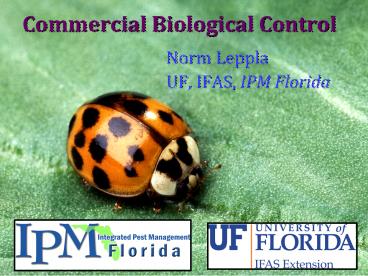Commercial Biological Control - PowerPoint PPT Presentation
Title:
Commercial Biological Control
Description:
Title: PowerPoint Presentation Author: IFAS Entomology & Nematology Last modified by: Windows User Created Date: 3/29/2004 10:13:05 PM Document presentation format – PowerPoint PPT presentation
Number of Views:495
Avg rating:3.0/5.0
Title: Commercial Biological Control
1
Commercial Biological Control
- Norm Leppla
- UF, IFAS, IPM Florida
2
Milestones in Commercialization of Biological
Control
- 1895- Farming Trichogramma proposed
- 1926- Fillmore, mass prod. NE citrus pests
- 1929- Trichogramma on factitious host
- 1949- Chrysoperla colonization
- 1956- Predaceous mites, mites on strawberry
- 1968- Koppert established
- 1975- Trichogramma, European corn borer
- 1981- IOBC WGQC (AMRQC)
- 1988- Whitefly parasites, Europe glasshouses
- 1990- ANBP established in California
- 1995- Commercial artificial diet for predators
- 1995- IBMA established in France
3
Biological Control Organizations with Commercial
Affiliations
4
Guidelines for Purchasing and Using Commercial
Natural Enemies and Biopesticides in Florida and
Other States (EDIS IPM-146 IN849)
The Association of Natural Biocontrol Producers
(ANBP) is a professional, non-profit association
representing the biological pest management
industry. Members of ANBP are expected to adhere
to a code of ethics which encourages the highest
standards in the production and marketing of
natural enemies. www.anbp.org
5
Commercial Natural Enemies and Biopesticides in
Florida
- 56 commercial invetrebrate biological control
products available in Florida (230 species
invertebrates globally) - 21 biopesticides available in Florida
- 51 suppliers for Florida (250 globally)
- 20 producers in North America, 0 in Florida
(5/20 produce gt3 species, 10 employees average) - Revenue 20-25 million for invertebrate
products produced in North America , 3 companies
gt 1.5 million (200 million globally)
6
Global Sales
2
7
(No Transcript)
8
Table 1. Habitats, pests, natural enemies and
reference number
9
Tables 2-7. Number of natural enemy products and
sources
- Table 2- Nematodes (8, 30)
- Table 3- Predatory mites (10, 26)
- Table 4- Predatory insects (15, 31)
- Table 5- Parasitic wasps (23, 31)
- Table 6- Biopesticides (21, 29)
- Table 7- Companies and websites (51)
10
Nematodes and Mites
- NEMATODES
- Heterorhabditidae- Heterorhabditis (2 spp)
- Steinernematidae- Steinernema (3 spp)
- ARACHNIDS
- Laelapidae- Hypoaspis (1 spp)
- Phytoseiidae- Amblyseius, Galendromus,
Mesoseiulus, Neoseiulus, Phytoseiulus (9 spp)
11
Predatory Insects
- Coleoptera
- Coccinellidae- Cryptolaemus, Delphastus,
- Hippodamia, Rhyzobius, Stethorus
- Cybocephalidae- Cybocephalus
- Histeridae- Carcinops
- Staphylinidae- Dalotia (also called Atheta)
- Diptera
- Cecidomyiidae- Aphidoletes, Feltiella
- Hemiptera
- Anthocoridae- Orius
- Pentatomidae- Podisus
- Neuroptera
- Chrysopidae- Chrysoperla
Thysanoptera Thripidae- Scolothrips
12
Parasitic Wasps
- Hymenoptera
- Aphelinidae- Aphelinus, Aphytis, Encarsia,
Eretmocerus (5 spp) - Braconidae- Aphidius, Cotesia, Dacnusa (5
spp) - Encyrtidae- Leptomastix, Metaphycus (2 spp)
- Eulophidae- Diglyphus, Pediobius (2 spp)
- Pteromalidae- Muscidifurax, Nasonia,
Spalangia (6 spp) - Trichogrammatidae- Trichogramma (3 spp)
13
Major Commercial Natural Enemies
14
Major Commercial Natural Enemies
15
Predators!
16
Comparison of Chemical and Biological Control
Aspect Chemical Control Biological Control
Number of ingredients tested gt3.5 million 3,500
Success ratio 1140,000 110
Developmental costs 256 million 2 million
Developmental time 10 years 10 years
Benefit/cost ratio 21 2.5201
Risks of resistance Large Nil/small
Specificity Small Large
Harmful side-effects Many Nil/small
Van Lenteren, J. C. 2011. The state of
commercial augmentative biological control
plenty of natural enemies, but a frustrating lack
of uptake. Biocontrol.
17
Incentives to Use of Biological Control
- Effective against pest
- Safe for environment
- High benefit/cost
- Reduced long-term cost
- Reduced risk to growers
- Reduced compliance
- Attitude of consumers
- Residue demands by food retailers
- and supermarket chains
18
Limitations to Use of Biological Control
- Attitude of the pesticide industry
- Attitude of farmers
- Attitude of governmental institutions
- Influence of guidelines and regulations
- Attitude of biological control community
19
Requirements for Commercialization
- Incorporation into IPM system
- Distirbution system and marketing
- Expertise (training)
- New markets and products
- Research support (team versus solo) Improved
rearing and release methods - Field tests to determine effectiveness
- Compatibility with pesticides
- Taxonomic expertise
- Quality control
- Supportive regulatory structure
20
IPM Transition
Resistant Crop Competitors Natural enemies
Resistant varieties
Invasive Pest
Vulnerable Crop
- Integrated pest management program
- Cultural practices
- Scouting, ID of pests NEs
- Conservation of NEs
- Augmentation of NEs
- Reduced-risk insecticides
- Resistance management
- Pesticide program
- New insecticides
- New formulations
- New application methods
- Resistance management
21
Natural Enemy Sales Increases
- Pesticide resistance
- Transgenic crops
- Loss of pesticides (regulatory)
- New more selective pesticides
- Cost of pesticides (registration)
- Alien invasive species
- Cropping systems (pollinators, organic)
22
New Product Development
23
Amblyseius swirskii
24
Western Flower Thrips Control in Cucumbers
Mite Species
25
Bemisia tabaci Control on Hibiscus
Release dates
A. swirskii per plant B. tabaci with A.
swirskii B. tabaci without A. swirskii
26
Amblyseius swirskii Effectiveness
- Very high numerical response to availability of
food - Highly efficacious against western flower thrips,
greenhouse whiteflies and tobacco whiteflies - In combination with
- Orius spp. against western flower thrips
- Whitefly parasites against whiteflies
- P. persimilis or A. californicus against
two-spotted spider mites - Good establishment on pollen
- Whiteflies can substitute for pollen in peppers
- Good results in North and South Europe
- May replace A. cucumeris, depending on release
permits
27
Pesticide Side Effects
28
Global QC Programs
- Individual CompaniesCustomers
- International StandardsISO 9000 IOBC Guidelines
(European Community) - The Marketplace Quality Products
29
Customer Service
- Many companies provide detailed information on
how to use their products. - The best companies deliver excellent customer
service for site-specific biocontrol. - The marketplace ultimately determines the
usefulness of commercial natural enemies.
30
Information on Commercial Biological Control































